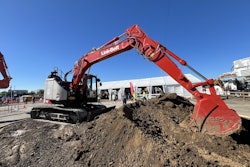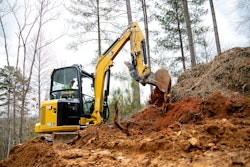The vast variety of concrete saws in the marketplace makes choosing the right one difficult. Having a good understanding of what you’ll be cutting is the best way to make this easier.
If you’re buying a concrete flat saw, you should first consider the blade that will be used in your application, says Ed Varel, engineering project manager for Stone Construction Equipment. If you are a general contractor who will be making small cuts (10 feet in length or less) infrequently throughout the day, a small saw with a 14-inch blade and no automatic drive will work.
For bigger jobs such as cutting expansion grooves in highway slabs, self-propelled saws, which start out at 13 horsepower, are necessary. A depth control feature is also important when you need to cut to a certain depth for a long length.
If you are making control cuts in green concrete you’ll need a saw that distributes weight such that it won’t destroy the newly finished surface.
If you are using a chainsaw, you will get your best wear out of the bar and chain by sizing the bar so that you use its full length, says Dema Erbacher, technical support manager for RGC Products. Cutting in one area of a chainsaw’s bar can cause excessive wear in that spot and may ultimately end its life prematurally.
Don’t buy a saw that is too small or too big for the application. Many times contractors try to either buy the most powerful saw available or the least expensive, says Kent Johnston, Western zone sales manager for ICS, Blount. Both tactics can backfire. For example, if a large percentage of cutting is done on a wall or overhead, and the saw weighs 10 pounds more than a less powerful one that could get the job done, productivity will lag.
Conversely, some less expensive saws have limited features that don’t allow for versatility. Make sure the saw you buy includes a wet-cut kit and an air filter designed specifically for concrete cutting.
A high quality saw may cost more initially, says Russ Warner, product marketing manager, concrete/light compaction equipment, Ingersoll-Rand, but will provide a better return on your investment through lower maintenance costs, less downtime, longer life and higher resale value.
Proper saw operation
Even if you have the right the saw for your application, if you use it wrong, several things will suffer, including blade or chain life, productivity and the quality of your work. Here are some tips for proper saw operation:
Remove the protective coating on the diamond matrix prior to cutting. You can do this by cutting into something abrasive such as cinder block. Otherwise the diamonds won’t be exposed properly and the saw or blade won’t cut as it should.
Use the right chain or blade for your application. There isn’t one catchall chain or blade that will work for every application, Erbacher says. “If you use the wrong blade, you’re going to be throwing money away.” Call the blade manufacturer with questions about which blade to use and the saw maker with chain application questions.
Always step cut. You should cut 1 to 2 inches deep at a time no matter how deep the final cut will be. If you routinely try to make 8-inch cuts, for instance, in one pass you will ruin the blade quickly and the saw could bog down, giving you inconsistent cutting depths. “Some operators just want to get it done quick,” says Rebekah Gallert, product manager for demolition, Wacker, “so they’ll make a 3- or 4-inch cut in one pass.” This heats up the blade and causes it to warp.
Keep a constant check on water flow. If you have too much water, the saw could hydroplane or extra slurry could develop, creating an abrasive environment that wears out the diamonds in the cutting apparatus too quickly. Experienced operators will keep a close eye on the blade or chain as they are cutting and tweak the water flow.
Let the saw do as much of the work as possible. Pushing on the saw will not make it cut faster and will only accelerate operator fatigue. It also slows down rpms, causing productivity to decrease.
Don’t try to steer a saw back on course. Steering the saw while in the cut only reduces the side clearance of the diamond segments and reduces the life of the blade or chain. If your cut gets off course, it is better to get out of it and restart on the line.
Pay attention to the engine’s rpm. Experienced cutters have an ear for this and can speed up or slow down according to the concentration of aggregate in the concrete. If you try to cut too fast, often the saw will raise up out of the cut. Even if it doesn’t, your blades will wear faster. On the other hand, if you cut too slowly you’re not being efficient. Some manufacturers offer a speed-control feature that measures rpms and speeds the saw up or slows it down automatically. This is a good option to look for if your saw operators aren’t experienced.
Concrete dust kills engines
Maintenance on concrete saws often gets overlooked, but it’s crucial because of the environment in which they work. “When you’re cutting, you’re spraying out a lot of dust,” Varel says, “and that’s a killer for the engine and any lubricated joint.” To protect the saw from these fine particles, you need to remove dust from the air cleaner on the air filter and grease the lube points after every use. You also need to clean the machine after each use to prevent a buildup of grime and replace air filters at proper intervals.
Since concrete dust is a serious health hazard as well, make sure you follow OSHA standards for eye, nose and mouth protection.
Proper maintenance also increases blade life. And with some blades costing from a quarter to half the price of a small saw, blade life is very important, Varel says. Changing a blade is also the lead cause of downtime for concrete cutting operations.
Inspect belts, pulleys and bearings every 100 hours, Gallert says. Check the belt for tension and look for tears. If you neglect the belts and pulleys you’ll start to see poor cutting performance because the blade isn’t turning in a perfectly centrifugal path.
Peer advice
Fellow readers shared these strategies for using concrete saws:
“When the blade is not cutting as before, yet the diamond ring is still intact and is not worn out, put a few scars in the diamond ring with a cold chisel. The blade will resume cutting like a new one.”
-Wayland Sherman, president of Sherman Construction, Piedmont, South Carolina
“Run your blade through a concrete block on occasion to clear out some of the diamond segments.
Also, if the guide arm isn’t straight, you won’t cut straight.”
-Russ Pyles, sales manager for Equipment Finders, Nashville, Tennessee
“The two most important things I recommend are proper blade for the application and proper water flow to extend blade life.”
-Stan Helms, purchasing manager for March Westin, Morgantown, West Virginia










